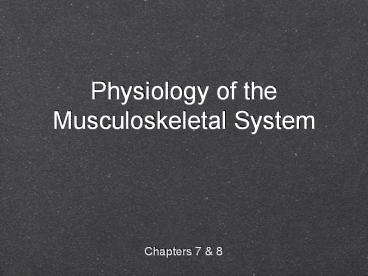Physiology of the Musculoskeletal System - PowerPoint PPT Presentation
Title:
Physiology of the Musculoskeletal System
Description:
Physiology of the Musculoskeletal System Chapters 7 & 8 – PowerPoint PPT presentation
Number of Views:3746
Avg rating:3.0/5.0
Title: Physiology of the Musculoskeletal System
1
Physiology of the Musculoskeletal System
- Chapters 7 8
2
1. Neuromuscular Anatomy
Pages 121-122, 126-129, 131, 136
3
Nervous System
Central Nervous System
Peripheral Nervous System
Central Nervous System
Peripheral Nervous System
3
4
Afferent Efferent
Afferent
Efferent
Central Nervous System
5
Neuron
6
Synapse
7
Neuromuscular Junction
8
Neuromuscular Junction
9
Action Potential
- Electrical impluse
- Neurons and muscle fibers
- Two phases
- Depolarization
- Sodium (Na)
- Potassium (K)
- Repolarization
- Sodium (Na)
- Potassium (K)
10
Action Potential
11
Action Potential
Depolarization
Repolarization
12
Motor Unit
Note This motor unit has a 31 ratio Actual
motor units range from 201 to 2,0001
13
(No Transcript)
14
Motor Units
- 100-1000 per muscle
- Fast and Slow
- All-or-None Principle
15
2. Muscle Anatomy Overview
Pages 141-152
16
Muscle Fiber Anatomy
Note muscle fiber muscle cell
17
Muscle Fiber Anatomy
18
Sarcomere
19
Myofibrils/Filaments - actin - myosin
20
Actin Myosin
1. Troponin 2. Tropomyosin 3. Actin
21
Actin Myosin
Actin
Myosin
22
3. The Sliding Filament TheoryExcitation-Contract
ion Coupling
23
Step-by-Step Summary of Excitation-Contraction
Coupling p. 145
Sliding filament theory
http//www.blackwellpublishing.com/matthews/myosin
.html
http//www.mhhe.com/biosci/esp/2002_general/Esp/fo
lder_structure/su/m4/s11/sum4s11_9.htm
24
Neural Stimulation
25
Action Potentials Acetylcholine
26
Calcium
27
(No Transcript)
28
Cross-Bridges Power Strokes
29
Sliding
30
Sliding
Relaxed
Partial
Maximal
31
ATP (?)
1.
2.
32
(No Transcript)
33
Quick Time Movie
- This Quick Time Movie of the contraction process
can be downloaded at the class web page.
34
Muscle Force
- Force The capacity to do work or cause physical
change - When in the sliding filament theory is muscle
force actually produced?
35
4. Types of Muscle Contraction
- Static contraction
- Isometric
- Dynamic contraction
- Concentric
- Eccentric
Pages 158-159
36
Isometric
37
Isometric or Static Contraction
38
Concentric
39
Concentric Contraction
40
(No Transcript)
41
Eccentric Contraction
42
Eccentric Contraction
43
Eccentric Contraction
Lengthens
Lengthens
44
5. Muscle Fiber Types
Most Common Slow twitch/Type I Fast twitch
A/Type IIa Fast twitch B/Type IIb
Type IIx
Pages 153-154
45
Fiber Type Characteristics
Fast Fibers Slow
fibers Characteristic Type II Type I Resistance
to fatigue Low High Predominant energy
system Anaerobic Aerobic Speed of
shortening Fast Slow Force production High
Moderate Fiber Diameter Large Small Others
46
Fiber Typing
FYI
47
Fiber Typing
FYI
The things Ill do for extra credit!
48
Fiber Typing
FYI
Type II
Type I
Type IIa
Type IIb
Type I
Fig 8.12
49
Fiber Types and Individual Differences
Western States 100 two weeks later won Badwater
Ultramarathon
107.5 kg (237 lbs) at clean jerk in 1997.
Bodyweight was 53.1 kg (117 lbs).
- What are the percentages of fiber types in the
average person?
50
Fiber Type Distribution
Sport Type I Type II
Distance Runner 70-80 20-30
Track Sprinter 25-30 70-75
Non-athlete 47-53 47-53
Table 8.2
51
Fiber Type Distribution
- Average person equal mix
- No sex difference
- No age difference
52
Fiber Type Distribution
53
Alterations in Fiber Types
- Shift
- skeletal muscle is highly plastic
- Complete change
- Fast twitch to Slow twitch
- rigorous and regular exercise
16 weeks of endurance training
6 increase in Type I
1 decrease in Type IIa
5 decrease in Type IIb
54
6.Muscle Receptors
Pages 163-165
55
Stretch Reflex
- stretch or increase length of the muscle...
- ...muscle contraction
56
(No Transcript)
57
(No Transcript)
58
(No Transcript)
59
Golgi Tendon Organ
2.
1. Contraction
3.
4. Inhibition































